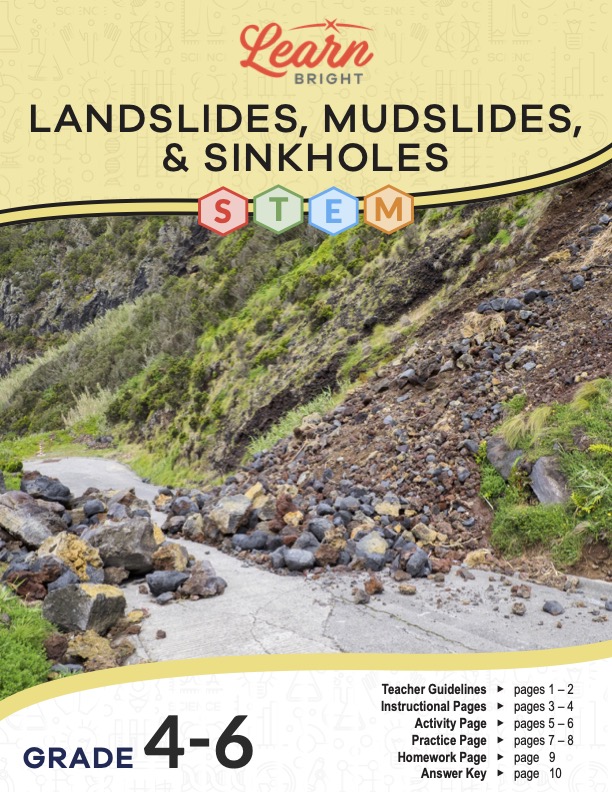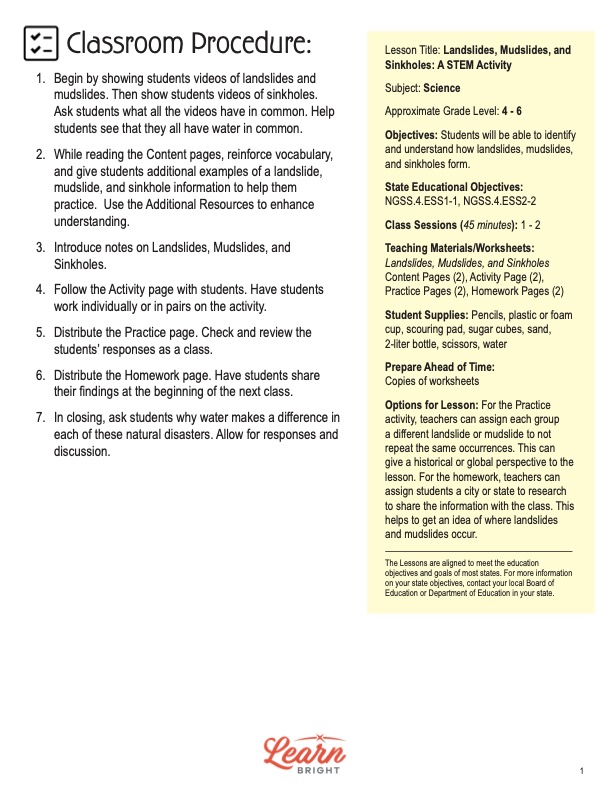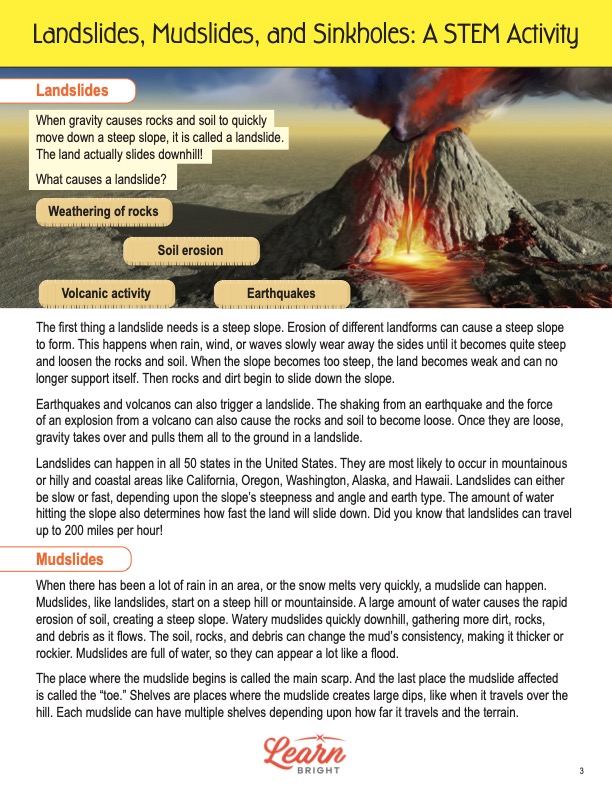Description
What our Landslides, Mudslides, and Sinkholes STEM lesson plan includes
Lesson Objectives and Overview: Landslides, Mudslides, and Sinkholes STEM introduces students to how these disasters form. Students will learn about the various characteristics of each disaster and explore the role of water in causing them. This lesson is for students in 4th grade, 5th grade, and 6th grade.
Classroom Procedure
Every lesson plan provides you with a classroom procedure page that outlines a step-by-step guide to follow. You do not have to follow the guide exactly. The guide helps you organize the lesson and details when to hand out worksheets. It also lists information in the yellow box that you might find useful. You will find the lesson objectives, state standards, and number of class sessions the lesson should take to complete in this area. In addition, it describes the supplies you will need as well as what and how you need to prepare beforehand. For this lesson, you need pencils, plastic or foam cups, scouring pads, sugar cubes, sand, two-liter bottles, scissors, and water.
Options for Lesson
You will find several suggestions for additional ideas and activities in the “Options for Lesson” section of the classroom procedure page. One idea related to the practice activity is to assign each group a different landslide or mudslide so that none of the students repeat the same occurrence. This can provide a historical or global perspective to the lesson. And for the homework, assign students a city or state to research and have them share what they discover with the class. Doing this can help students get an idea of where these specific disasters occur.
Teacher Notes
The teacher notes page provides an extra paragraph of information to help guide the lesson and remind you what to focus on. The blank lines on this page are available for you to write out thoughts and ideas you have as you prepare the lesson.
LANDSLIDES, MUDSLIDES, AND SINKHOLES STEM LESSON PLAN CONTENT PAGES
Landslides
The Landslides, Mudslides, and Sinkholes STEM lesson plan contains three content pages. The first page focuses on landslides and details how they occur. When gravity causes rocks and soil to quickly move down a steep slope, we call this event a landslide. Weathering, erosion, volcanic activity, and earthquakes are four common causes.
Erosion of different landforms can cause a steep slope to form. This happens when rain, wind, or waves wear away the sides slowly until the area becomes quite steep. The rocks and soil also start to loosen up. When the slope becomes too steep, the land becomes weak and can no longer support itself. As a result, the rocks and dirt being sliding down the slope.
Earthquakes and volcanoes also trigger landslides because of the shaking movements or explosions from the earth. Both loosen up rocks and soil on the earth’s surface. At this point, gravity takes over and pulls the debris toward the ground in a landslide.
Landslides can happen in all 50 states across the country. Most often, however, they occur in mountainous or hilly areas, as well as coastal regions like California, Washington, Hawai’i, and Alaska. The speed of debris flow varies from slow to fast, depending on the slope’s steepness and angle and the type of earth moving. In addition, water can affect the flow speed if it hits the slope.
Mudslides
Students will learn that mudslides basically a type of landslide that involves dirt and water. When there has been a lot of rain or when snow melts quickly, a mudslide can occur. Mudslides start on a steep hill or mountainside. A large amount of water causes the rapid erosion of soil, creating the steep slope.
Watery mud slides downhill quickly, gathering more dirt, rocks, and debris along the way. The soil, rocks, and debris can change the mud’s consistency, making it thicker or rockier. Mudslides often appear much like a flood because of the high water content.
The area where a mudslide starts is called the main scarp. The ending point is the toe, and this is the last place the mudslide affected. Shelves are places where the slide creates large dips, like when it travels over the hill. Each mudslide can have multiple shelves, depending on how far it travels and the terrain of the region.
Students will learn that mud is very powerful when it consists of so many rocks. Some mudslides have even carried boulders, trees, cars, and houses. They can cause a lot of damage and often cause people to lose their property or lives as a result. They happen in areas with steep slopes affected by erosion. Even when people build a house on the side of a mountain, they can trigger a mudslide.
Sinkholes
The last thing students will learn about is the sinkhole. A sinkhole is essentially a big hole in the ground. Erosion causes sinkholes, but instead of starting on top of a steep hill, they begin underground. They happen in areas where the bedrock comprises limestone, which dissolves from water erosion. Such erosion provides a route for surface water to go underground.
In general, sinkholes develop gradually, and they most often occur in Florida, Texas, Alabama, Kentucky, Tennessee, and Pennsylvania. (These states have large areas of limestone bedrock.) Sinkholes can be very dangerous. In the past, they have swallowed cars and even houses. There are three main types: dissolution or solution, cover-subsidence, and cover-collapse.
The first type is the dissolution or solution sinkhole. This type involves little soil or plant life over the limestone. Water trickles down through crevices in the stone and dissolves it. A depression slowly forms, but this kind of sinkhole isn’t dangerous. The result after a while is often a pond.
Cover-subsidence sinkholes happen in areas where sand covers the bedrock and enters the crevices, causing the land to become heavier and sink. Erosion makes the crevices larger, allowing even more sand to enter and making it even heavier. The heavier the area becomes, the more it sinks.
The last type of sinkhole is the cover-collapse. This kind occurs in places where clay covers the bedrock layer. Water erodes away a cavern underneath, making the top layer thinner and thinner. When the top layer becomes too thin, it collapses and opens up a sinkhole. This kind of sinkhole is the most dangerous of the three.
LANDSLIDES, MUDSLIDES, AND SINKHOLES STEM LESSON PLAN WORKSHEETS
The Landslides, Mudslides, and Sinkholes STEM lesson plan includes three worksheets: an activity worksheet, a practice worksheet, and a homework assignment. Each one will reinforce students’ comprehension of lesson material in different ways and help them demonstrate when they learned. Use the guidelines on the classroom procedure page to determine when to distribute each worksheet to the class.
SINKHOLE SIMULATION ACTIVITY WORKSHEET
For the activity, students will gather the materials you provide. First, they will trace the bottom of the cup onto a scouring pad and cut out the resulting circle. After making a hole in the bottom of the cup the size of their finger, they will place the pad on the bottom of the cup. In the center of the cup, they will stack sugar cubes until they reach the top. They will then fill the rest of the cup with sand and also cover the top with a thin layer of sand.
With the bottle, students will cut off the bottom so that it is the same height as the cup. They will fill the bottle dish a third of the way with water and place the sand and sugar cup in the water dish. The worksheet lists five questions that students will answer according to the observations they make. These questions include information such as the type of rock the sugar cubes represent or what caused the sinkhole to happen.
LANDSLIDES, MUDSLIDES, AND SINKHOLES STEM PRACTICE WORKSHEET
The practice worksheet requires students to research either a recent or historical landslide or mudslide event. They can read articles or other resources to find information on their chosen event. The worksheet lists seven questions for them to answer through their research. After they finish their responses, they will create a slideshow presentation to present their findings to the class.
DAILY NEWS REPORT HOMEWORK ASSIGNMENT
Students will research recent reports on a landslide, mudslide, or sinkhole. They will write a news article about the event using the template on the worksheet. You may want to suggest they write a rough draft first and then use the worksheet for the final copy.
Worksheet Answer Keys
There are answer keys for the three worksheets of this lesson plan. Students’ responses for the practice and homework worksheets will all vary because of the nature of the assignments. However, while there may be some variation in their responses for the activity questions, their answers should still somewhat reflect those on the answer key. If you choose to administer the lesson pages to your students via PDF, you will need to save a new file that omits these pages. Otherwise, you can simply print out the applicable pages and keep these as reference for yourself when grading assignments.









